Higher Grounds: Raül Bobet Transforms Practices and Traditions in a New Vineyard in The Catalan Pyrenees Mountains, Northern Spain (5-Bottle Pack $299) + Saturday Sips Returns
Join us for Saturday Sips
‘La Diada de Sant Jordi’ falls on April 23 in the Catalan holiday calendar, a day of books and roses, and it is a great reason to resume our all-day, in-store Saturday sips. Among the themes we will be exploring in weeks to come is ‘vinecology’—the agricultural and techno-fixes that will alter the world of wine as profoundly as global climate change is altering traditional (and non-traditional) wine growing areas.
This Saturday we will be sampling and celebrating ‘All Things Catalunya’ with a selection from the wine portfolio of Castell d’Encus.
Most winemakers provide both the brains and the brawn of their operation, but our featured enòleg, Raül Bobet of Castell d’Encus, takes it to extremes. With a degree in chemical engineering and a Ph.D. in oenology, Bobet manages three hundred lofty acres in the sub-Pyrenees where Hospitaller monks once cultivated wines—Bobet’s wines are still fermented in the ancient stone tureens carved by these holy men. An obligation to the unity between art and science and the primacy of geography forms the spiritual basis of the Bobet ethos; the wines represented in this week’s package are a paean to the variety and depth of Catalunya wines, the ‘land of castles’, whose treasury continues to amaze us with its many surprises.
The Vigneron’s Dilemma
It’s no secret that grape vines have been known to produce the best wines where the challenges are greatest. Vines placed under natural stress, struggling to find water and nutrients, tend to produce fruit that is more vibrant in flavor and balanced in acid with smoother tannins. Sites that are flat, well-irrigated and sunny—in short, no-brainer terroirs that over produce and under perform.
But with climate change putting pressure on all agricultural products, the human brain, like the farms themselves, are being put to the test. Vignerons like Raül Bobet are pulling out all stops to find innovative ways to produce quality wines in off-the-beaten-track regions that have become slightly warmer in recent decades, and thus, more hospitable to vines.
Like the old Inuit following the caribou, modern winemakers are being forced to follow the thermometer.
(Climate) Change is Afoot
With a total more than two million wine-producing acres, Spain has the largest area of vineyards in the world. It stands to reason that nuanced and sensitive agricultural products like grapes would be especially impacted by rising summer temperatures and milder, wetter winters. And according to the national weather office Aemet, over the past 60 years, average temperatures in Spain have risen by 1.3 degrees Celsius.
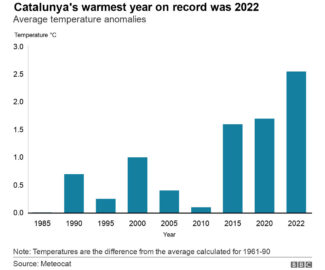
Says Catalan vigneron Gay de Montellà Estany, “In the past decade, temperatures have brought the grape harvest forward by 10 to 15 days. We have to harvest at the start of August when the heat is the most intense.”
As a result, timing the harvest becomes perhaps the most critical decision a modern winemaker has to make—done too early, when the grapes have not reached full phenolic ripeness, many compounds that affect aroma and flavor are not matured. Alternately, if the winemaker waits too long, the fruit has less acidity and increased sugars, resulting in higher alcohol with a profile that may come across as flabby. In either case, says Fernando Zamora, a professor in the oenology department at Rovira i Virgili University in Catalunya: “These grapes have not ripened in the right way.”
Counter or Adapt
The most delicious irony in changing weather patterns may be that as old wine appellations are dealt increasingly severe blows, regions once considered too cold for vines are warming to the point that they can produce quality wines.
In Catalunya, vineyards at the foothills of the Pyrenees are being planted at altitudes up to 4,000 feet. “Twenty-five years ago, it would have been impossible,” says Miguel Torres Maczassek of Familia Torres. “At higher elevations, peak temperatures are not necessarily much cooler, but intense heat lasts for shorter periods and nighttime temperatures are colder than at lower altitudes. This increased diurnal shift (the temperature swing over the course of a day) helps grapes to ripen at a more even pace, over a longer period of time, than where temperatures remain relatively stable.”
But pushing altitudes also creates challenges: Soils, particularly on slopes, are generally poorer, water is scarcer and unexpected weather events like frosts and hailstorms are always a threat. Whereas this may ultimately result in better wine overall, the challenges for winemakers are prodigious.
In the northeast of Spain, including coastal vineyards, the response has been two-fold: Adapt current vineyards to the ‘new normal’ by replanting to more heat-tolerant varietals, or eke out space at higher elevations to take advantage of the plus-side of a global negative.
Raül Bobet of Castell d’Encus is doing both.
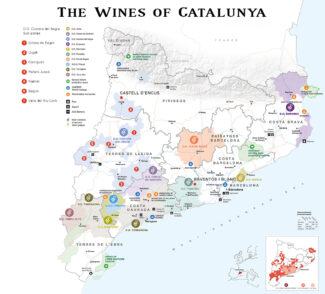
Castell d’Encus
A Reflexive Vineyard Project
“Our philosophy is that of an organic vineyard, without herbicides, insecticides or fungicides that are not included in organic practices.” – Raül Bobet
Above all, Castell d’Encus is an experiment, and one that has been approached with all the precision and insight of a research scientist. The goal, from the outset, was to discover the methodology behind reflective, subtle, non-explosive and low-alcohol wines with aging potential at an altitude where even the old-time winemakers claimed that grapes could not thrive.
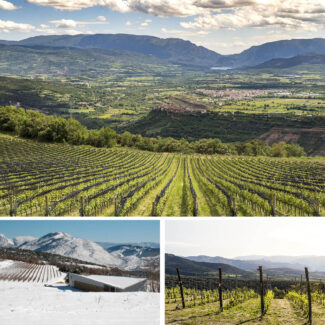
Castell d’Encus, Talarn, Lleida
But the grand experiment has a more ecological edge, and according to Bobet, “It was vital to us to pair an excellence in mountain winemaking with environmental protection. We want to channel new actions to increase biodiversity and create awareness as an example that everyone can get involved in taking care of the Earth. From our situation, we carry out actions in order to reduce the human impact on the land, the vineyard and the environment, without using herbicides or fungicides. We take advantage of the force of gravity and geothermal energy for certain tasks in the winery.”
Uphill at Costers del Segre
Gradually moving into the modern spotlight, Costers del Segre is a Spanish Denominación de Origen for wines produced in the Catalan province of Lleida. The name is derived from the Segre river which flows from the Pyrenees mountains and reaches the Ebro River south of Lleida. The region grew to prominence as a result of a single estate, Raimat, located near the DO’s westernmost point. Raimat is Spain’s largest privately-owned winery and is considered to be one of its most inventive.
Somewhat unique in the annals of appellations, Costers del Segre was created from four separate sub-zones within a larger region; three further sub-zones were identified in 1998. Altitudes range from 800 feet to 2400 feet, and the influence of the Pyrenees offers a continental climate but the proximity of the Mediterranean reduces the risk of frost when the vines are most vulnerable. The days are warm but the nighttime temperatures are low, ensuring that the grapes retain an excellent spine of acids and structure.
Old vine plots of bush-trained Garnatxa and Macabeu can be found scattered through the region but most of the activity in the last two decades has been new plantings, especially of international varieties in innovative, wire-trained vineyards.
The Terroir: Resurrecting Ancient Optimal Land
Winemaking traditions may not be written in stone, but the fermenting vats of Castell d’Encus are carved into bedrock. Nine stone vats (called ‘cups’), capable of holding between two and eight tons each, were created by Hospitaller monks in the 12th century—strong indication that the area was once considered optimum wine territory.
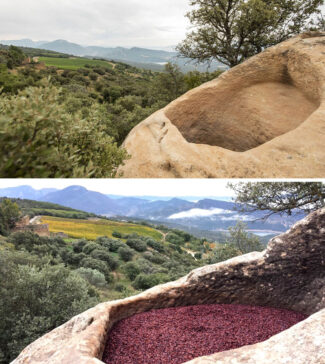
12th Century Stone Vats (Fermenters)
Like many such pockets of vineland, the blight of root-devouring phylloxera in the nineteenth century (along with a declining rural population) dealt a blow to the area’s winemaking industry, but visionaries like Raül Bobet have realized that there is gold in the mountains of Encus. Cool climates confer pronounced acidity to wine and this translates to stabilization, protection and a better aging potential. What the Hospitaller monks intuited and proved centuries ago is only made better with the slightly-warmer temperatures of the modern era.
Bobet discovered the terroir of d’Encus in 2001; he refers to it as his ‘project’ rather than as his winery: “The environment is very important to us. Our heat pumps work using geothermal principles and we remain mindful and appreciative of the natural surroundings, integrating the project environmentally, protecting the fauna—to this effect we have a safekeeping agreement with the Pallars Jussà Biological Field Station. An important idea is that d’Encus is a team project where people are what matters, along with all those who tend our vineyards, Encus would be inconceivable.”
Raül Bobet: Author and Interpreter of Vinecology
“When we drink a wine, we are drinking the countryside it comes from; its climate and its land.” – Raül Bobet
By the age of three, when he first began stomping grapes to help out in the family bodega, the wine bug had its claws in Raül Bobet’s sense of self. His first love has always been nature, but since wine is, at its essence, a natural product, it followed that his approach to its creation would combine art and science. “At university I was given the necessary scientific methodology and rigor to make wine technically, but in the end it comes down to enthusiasm, to passion; and that’s how I ended up dedicating my heart and soul to it.”
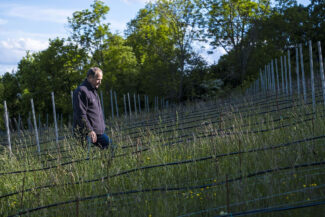
Raül Bobet, Castell d’Encus
The long-time technical director for Familia Torres, Bobet had long been keeping an eye on the impact of global warming on the wine industry, and in 2001, three thousand feet above sea level, he had a vision of the future: “A total of 320 acres shape the d’Encus estate and give the project its name. It is a privileged location, between 2,600 and 3,200 of altitude, where exceptional wines are born. The vineyard is managed according to organic viticulture principles—‘vinecology’—and represents 67 acres of the estate. Yields are low and soils are poor in organic matter; we find varieties such as Riesling, Albariño, Sauvignon blanc, Sémillon, Pinot noir, Syrah, Cabernet sauvignon, Cabernet franc, Merlot, Petit Verdot and Grenache do well here.”
When asked why he favors such non-indigenous varieties, he is quick to point out the canon of work that already exists for these grapes; it is interpretation of them within a rarefied atmosphere that fascinates him and the results are an amazing compendium of high-altitude classics.
All vineyards grow at elevations averaging 3,200 feet where southerly exposures allow optimum ripeness in the face of the shorter growing seasons.
The What and Why
Raül Bobet’s scientific background, including advanced degrees in oenology, leads to some dry know-how, but it is all founded on research—his lifelong pursuit: “Discovering has been the reason that has brought us where we are,” he says. “It is a constant challenge to understand all the variables that can lead us to the style of freshness we seek in our wines, but with complexity and personality.”
He writes blog where the finer points of winemaking are examined in detail, including the impact of tartaric instability, protein precipitates and the polarity of the solvent effect on colloids. Such esoterica may be above the pay grade of most wine lovers, but they speak directly to the compulsive quest for improvement that lies at the heart—and soul—of Castell d’Encus.
Says Bobet: “We want to make wines with a very clear style, maintaining freshness as the backbone and avoiding over-ripeness and over-extraction. We seek elegance and subtlety, but without giving up the complexity and roundness of the wines. No doubt, the grape plays, in this sense, a main role.”
He adds, “All the wines are made in small batches in order to respect their traceability and to be able to create the ideal blends, as well as to have a good basis for research, one of the pillars of the winery. Our wines come solely from grapes from our vineyards and are made exclusively in our facilities, which work by gravity. We do not use pumps in the processes of solid movements, thus avoiding the unwanted effects of seeds breaking and achieving a better control of the skins quality.”
Cabernet Sauvignon & Company: A Question
As English is the international business language, it may be suggested that the four Bordeaux varieties are the global benchmark for red wine. All of these are cultivated in the rooftop vineyards of Raül Bobet, who recognizes that the reputation preceding these grapes are a goal, especially at high altitudes; the average elevation of Bordeaux is under two hundred feet.
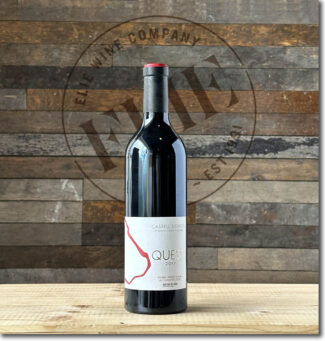 Castell d’Encus ‘Quest’, 2017 Costers del Segre ($66)
Castell d’Encus ‘Quest’, 2017 Costers del Segre ($66)
‘Quest’ is the heart of the matter—the question itself: Can Bordeaux varieties produce at such elevations? The answer is yes, as this elegant blend of 55% Cabernet Sauvignon, 20% Merlot, 15% Cabernet Franc and 10% Petit Verdot demonstrates. 100% fermented in the estate’s famous stone vats, Quest displays a nicely concentrated profile with bright summer fruit and the hint of green pepper that is often a hallmark of cool climate reds. The tannins are finely-grained and linger with the acidity, showing great potential for cellaring. 360 cases made.
Pinot Noir: Broken
‘Acusp’ is the Latin word for ‘broken’ and refers not to the wine, but the mountain-top where the vineyards are located. Raül found the word in the first texts that mention the Encus range.
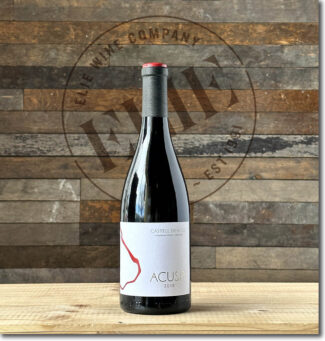 Castell d’Encus ‘Acusp’, 2018 Costers del Segre ($66)
Castell d’Encus ‘Acusp’, 2018 Costers del Segre ($66)
Hand-harvested using small, 10 kg crates, this 100% Pinot Noir wine, drawn from high-density vines, was fermented in a combination of stainless-steel tanks and in the open-air stone vats. It underwent secondary, malolactic fermentation in French oak barrels and has a light, silky mouthfeel with modest tannins and acidity behind savory, earthy aromatics accented by scents of white peaches, lilac and bright citrus, raspberry and chalk. 1500 cases made.
Riesling: Divine Unity
‘Ekam’ means ‘divine unity’ in Sanskrit, and refers to the Bobet-inspired blend of Riesling and Albariño.
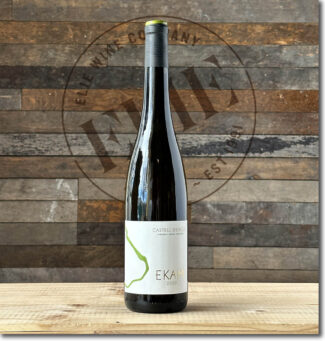 Castell d’Encus ‘Ekam’, 2020 Costers del Segre ($45)
Castell d’Encus ‘Ekam’, 2020 Costers del Segre ($45)
85% Riesling and 15% Albariño, Ekam offers an intense bouquet of kiwi, grapefruit, peach and ripe green apple and light kerosene notes which will develop and mature with age. Fermented in 2500- and 5000-liter tanks at low temperature, it is ‘trocken’, or dry. 2250 cases made.
Sauvignon Blanc: Obsession
‘Taleia’ is the Catalan word for ‘obsession’ and reflects many aspects of Raül Bobet’s personality. Sauvignon blanc is a grape which reaches its French apogee near river banks, but here it grows on a literal apogee in the Lleida Pyrenees high above the Catalan countryside.
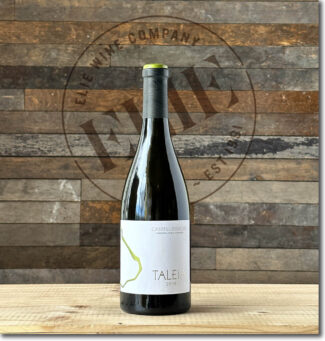 Castell d’Encus ‘Taleia’, 2018 Costers del Segre ($48)
Castell d’Encus ‘Taleia’, 2018 Costers del Segre ($48)
95% Sauvignon Blanc, 5% Semillon; this classic Bordeaux lowland blend as interpreted by Raül Bobet’s mountain sensibilities: Fermented on native yeast in a combination of medieval stone vats, French oak and stainless steel, a time on the lees adds richness and complexity. The wine presents notes of vanilla from the barrel-time, which melds wonderfully with the fruit’s essential quince, apricot, lime and straw flavors. 1700 cases made.
Sauvignon Blanc & Semillon: Ancestral Magic
‘Taïka’ is the Finnish word for ‘magic.’ Using the same pronunciation in Japanese, it means ‘new wave’. Combining new wave with an old wave, the ‘ancestral method’–the oldest known technique for making sparkling wines—Bobet’s Taïka is made by bottling it partway through its primary fermentation, thus trapping carbon dioxide gas to create gentle, bubbly carbonation. Without adding sugar and allowing an integration of the lees, such ancestral wines are said to better reflect the fullness of a given terroir.
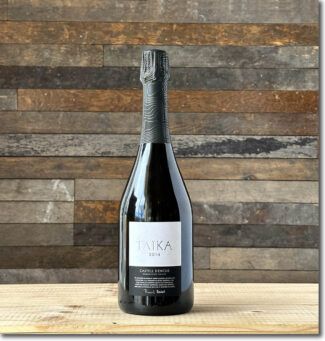 Castell d’Encus ‘Taïka’, 2014 Costers del Segre ‘Ancestral Method’ ($74)
Castell d’Encus ‘Taïka’, 2014 Costers del Segre ‘Ancestral Method’ ($74)
Half Sauvignon Blanc and half Semillon, aged more than 60 months before release, this delicately lush and creamy sparkler shows crisp citrus, warm yeasty notes and buttered brioche to compliment a refreshing acidity and a long, mineral finish. 300 cases made.
NEW ARRIVAL
Manuel Raventós Negra
Catalan Haute Couture
Haute couture is the ultimate expression of style, whether made manifest in clothing, art or wine. The word ‘couture’ may, in this instance, apply to anything handmade, but to add the qualifier ‘haute’, the requirements are more stringent.
Nowhere is Catalan high style and sensibilities better expressed than in the wines of the Raventós family, who boast among the longest winemaking traditions in the world, and occupying the same land since 1497.
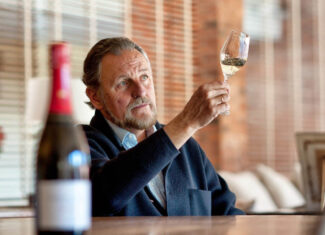
Manuel Raventós
Manuel Raventós’ personal selection of the best wines of the 2015 vintage, he considers it his ‘personal coupage’—a word that he uses interchangeably with ‘assemblage’. Made only in exceptional vintages like 2015, it is a follow-up to 2013. In search of a more voluminous wine, he returned to an earlier blend of 70% Xarel·lo and 30% Macabeu from vines planted in 1983 and allowed 70 months of lees aging. Disgorgement took place on 20 September 2022. The wine displays fine yeast notes, smoke and toast aromas with a hint of curry. 1,805 bottles and 518 magnums produced.
Down to Earth: The Primacy of Place
Conca del Riu Anoia, the name of a small geographical area, centered around the River Anoia Basin between the Catalan Pre-Coastal and Coastal Ranges.
Manuel Raventós considers the farm an ‘agricultural organism.’ Of the 222 acres, about half is vineyard; the rest is a mix of cereals, olive and almond trees and forests, with a lake and two hills making up the microclimate. Sheep and goats that graze among the vines to help to regenerate soil, while horses work the vineyard according to ancestral methods. The family lives on the estate, which was certified organic in 2009 by CCPAE and biodynamic by Demeter in 2013.
A Moment in Time: 2015
The 2015 vintage represented for northeast Spain a snapshot of the expression ‘It will all work out at the end.’
A balmy and temperate Spring led to a successful budburst, but then the ravages of climate change brought drought which affected most the vineyards throughout the rest of the season, broken only by a few rejuvenating showers. High altitude vineyards were less affected by the record-breaking temperatures, and indigenous grapes from well-established vines fared best.
The heat abated in September, and the grapes were brought in with nicely balanced fruit and acid and the best examples have great aging potential.
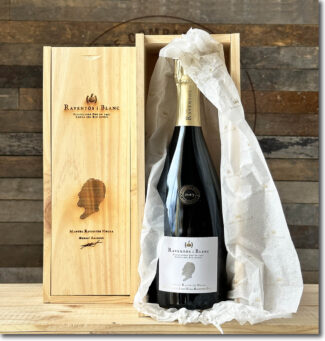 Raventós i Blanc ‘MRN’, 2015 Brut Conca del Riu Anoia (Barcelona-Espumoso) ($130)
Raventós i Blanc ‘MRN’, 2015 Brut Conca del Riu Anoia (Barcelona-Espumoso) ($130)
“Champagne producers claim that there is no terroir in the world that is better or as good as Champagne for making sparkling wine. This is quite implausible because it would be too much of a coincidence if Dom Perignon’s chance invention just happened to take place precisely in the location with the best conditions for sparkling wine.” – Manuel Raventós Domènech
The wines that Manuel Raventós selected for this vintage were Xarel·lo (25%) from the Clos, Macabeu (38%) from the Vinya dels Fòssils and Parellada (20%) from La Creueta. As always, the original Penedès coupage relied entirely on native yeast and proves out Manuel Raventós Domènech belief that sparkling wine to rival Champagne could be made on his estate.
Six years of aging in stacks give it a bright gold color and an enveloping silkiness with a long, bitter finish typical of wines from the Conca del Riu Anoia.
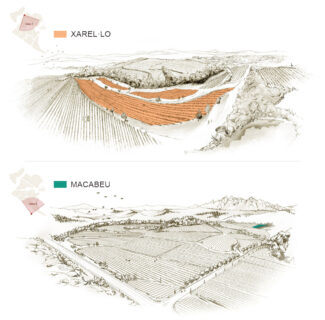
- - -
Posted on 2023.04.14 in France, Saturday Sips Wines, Spain DO, Wine-Aid Packages, Costers del Segre
Featured Wines
- Notebook: A’Boudt Town
- Saturday Sips Wines
- Saturday Sips Review Club
- The Champagne Society
- Wine-Aid Packages
Wine Regions
Grape Varieties
Albarino, Albarín Blanco, Albarín Tinto, Albillo, Aleatico, Aligote, Arbanne, Aubun, Barbarossa, barbera, Biancu Gentile, bourboulenc, Cabernet Franc, Caino, Caladoc, Calvi, Carcajolu-Neru, Carignan, Chablis, Chardonnay, Chasselas, Cinsault, Clairette, Corvina, Counoise, Dolcetto, Erbamat, Ferrol, Frappato, Friulano, Fromenteau, Gamay, Garnacha, Garnacha Tintorera, Gewurztraminer, Graciano, Grenache, Grenache Blanc, Groppello, Juan Garcia, Lambrusco, Loureira, Macabeo, Macabou, Malbec, Malvasia, Malvasia Nera, Marcelan, Marsanne, Marselan, Marzemino, Mondeuse, Montanaccia, Montònega, Morescola, Morescono, Moscatell, Muscat, Natural, Niellucciu, Parellada, Patrimonio, Pedro Ximénez, Petit Meslier, Petit Verdot, Pineau d'Aunis, Pinot Blanc, Pinot Gris, Pinot Meunier, Pinot Noir, Pouilly Fuisse, Pouilly Loche, Poulsard, Prieto Picudo, Riesling, Rondinella, Rose, Rousanne, Roussanne, Sagrantino, Sauvignon Blanc, Savignin, Sciacarellu, Semillon, Souson, Sparkling, Sumoll, Sylvaner, Syrah, Tannat, Tempranillo, Trebbiano, Trebbiano Valtenesi, Treixadura, Trousseau, Ugni Blanc, vaccarèse, Verdicchio, Vermentino, Xarel-loWines & Events by Date
- July 2024
- June 2024
- May 2024
- April 2024
- March 2024
- February 2024
- January 2024
- December 2023
- November 2023
- October 2023
- September 2023
- August 2023
- July 2023
- June 2023
- May 2023
- April 2023
- March 2023
- February 2023
- January 2023
- December 2022
- November 2022
- October 2022
- September 2022
- August 2022
- July 2022
- June 2022
- May 2022
- April 2022
- March 2022
- February 2022
- January 2022
- December 2021
- November 2021
- October 2021
- September 2021
- August 2021
- July 2021
- June 2021
- May 2021
- April 2021
- March 2021
- February 2021
- January 2021
- December 2020
- November 2020
- October 2020
- September 2020
- August 2020
- July 2020
- June 2020
- May 2020
- April 2020
- March 2020
- February 2020
- January 2020
- December 2019
- November 2019
- October 2019
- September 2019
- August 2019
- July 2019
- June 2019
- May 2019
- April 2019
- March 2019
- February 2019
- January 2019
- December 2018
- November 2018
- October 2018
- September 2018
- August 2018
- July 2018
- June 2018
- May 2018
- April 2018
- March 2018
- February 2018
- January 2018
- December 2017
- November 2017
- October 2017
- September 2017
- August 2017
- July 2017
- June 2017
- May 2017
- April 2017
- March 2017
- February 2017
- January 2017
- December 2016
- November 2016
- October 2016
- September 2016
- August 2016
- July 2016
- June 2016
- May 2016
- April 2016
- March 2016
- February 2016
- January 2016
- December 2015
- November 2015
- October 2015
- September 2015
- August 2015
- July 2015
- June 2015
- May 2015
- April 2015
- March 2015
- February 2015
- January 2015
- December 2014
- November 2014
- October 2014
- September 2014
- August 2014
- July 2014
- June 2014
- April 2014
- March 2014
- February 2014
- January 2014
- December 2013
- November 2013
- October 2013
- September 2013
- August 2013
- July 2013
- June 2013
- May 2013
- April 2013
- March 2013
- February 2013
- January 2013
- December 2012
- November 2012
- October 2012
Search



